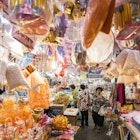

Maple leaves at sunset. Shinjuku Gyoen botanical garden is one of Tokyo's largest and most popular parks. Famous for autumn colour as well as cherry blossom viewing.
From seasonal sights and arts events to traditional festivals and tech expos, there is a lot happening in Tokyo from late September through to December – making the autumn months a great time to visit.

See the leaves change
Tokyo’s parks and gardens are a treat any time of year but especially when the maple trees turn from green to torii (a traditional Japanese gate) red in late November. Rikugi-en, Koshikawa Kōrakuen and Hama-rikyū Onshi-teien are some prime spots to lose yourself in a kaleidoscope of colours; Rikugi-en stays open a few hours past dark, turning on flood lights for the occasion.
- placement: fullWidth
- path: articles/in-content-top
- possible size: [970, 250], [970, 90], [728, 90], [300, 250], [320, 50], [1, 1],
- targeting:
{ "url": "tokyo-fall-best-things-see" }
You can also head to the hills to immerse yourself in the autumn phenomenon: Takao-san and Oku-Tama are two popular getaways, an hour and two hours respectively, by train from Tokyo (though fair warning, they can get very crowded).
While the maples are definitely showstoppers, don’t miss Tokyo’s signature tree – the gingko – whose leaves go gold in early December. Admire them from the terrace at Royal Garden Café on the appropriately-named Ichō Namiki-dōri (meaning, Gingko Street).

Rake in some luck
Tori-no-ichi (Rooster Fairs) have been a Tokyo tradition for centuries, held at shrines in November (the month of the rooster according to the Chinese zodiac).
Vendors sell kumade (bamboo rakes), that have been so lavishly decorated with symbols for wealth (like the god Ebisu), longevity (pine boughs and cranes) and happiness (owls) as to totally obscure their use – except metaphorically.
Hanazono-jinja in Shinjuku and Chōkoku-ji in Asakusa both celebrate Tori-no-ichi. They take place two or three times during the month, on ‘rooster days’.
- placement: fullWidth
- path: articles/in-content-middle
- possible size: [970, 250], [970, 90], [728, 90], [300, 250], [320, 50], [1, 1],
- targeting:
{ "url": "tokyo-fall-best-things-see" }

Go wild for Halloween
For decades Tokyo no more than raised an eyebrow at the spectre of Halloween; but now the city champions the American import. Thousands descend on Shibuya Crossing in costume for one big open-air party – you can elect to arrive in style, in a go kart and dressed as a cartoon or video game character, courtesy of Maricar.
Other popular gathering spots include Tokyo’s gay district, Shinjuku Nichōme – start the evening at Aiiro Café – and the rowdy bars and clubs of nightlife district Roppongi.
The city of Kawasaki (in between Tokyo and Yokohama) hosts a massively popular, other-worldly parade over the weekend closest to Halloween. For parts of September and the whole of October, Tokyo Disney Resort has Halloween-themed parades and decorations.

Have a moon-viewing party
You already know hanami (cherry blossom viewing), now meet its autumnal cousin tsukimi (moon viewing). Full moons in Japan from September to December are big and golden, just like a senbei (toasted rice cracker) hanging in the sky. The traditional day for tsukimi is the fifteenth day of the eighth month, on the old lunar calendar.
Every year, the garden Mukojima Hyakkaen stays open until 9pm for three days on and around the full moon for a lantern-lit celebration with live koto (zither) music. Yokohama garden Sankei-en hosts a similar event with music and dance staged at one of the garden’s antique pavilions.
And if you can’t make it to an event, all month you’ll see restaurants offering seasonal moon-themed treats, like tsukimi-dango (rice dumplings). Don’t despair if you’re visiting out of season though, you can get tsukimi-udon, noodles topped with a bright yellow egg yolk year-round.
Catch a show
Over the last week of October, Roppongi Hills rolls out the red carpet for the Tokyo International Film Festival, which includes a mix of Hollywood blockbusters, the latest installments from Japanese veterans and new flicks from up-and-coming directors around Asia. In November, there’s Tokyo Filmex, another film festival, but with a less commercial focus. Both are open to the public; most films are screened with English subtitles (but it’s best to double check).
- placement: native
- path: articles/in-content-native
- possible size: [f, l],
- targeting:
{ "url": "tokyo-fall-best-things-see" }
Festival/Tokyo, Japan’s biggest performing arts festival, runs throughout October and into November, with shows taking place in theatres – and on streets – around the city. Some are screened with English subtitles (or don’t use spoken language at all); check the website for details.

Tokyo's autumn foods
After a summer of beer, edamame and kakigōri (shaved ice), Tokyoites look forward to more earthy delights. King among them is the prized matsutake mushroom, which can cost hundreds of dollars per kilo. Look for them on sale at Tsukiji Outer Market. Saba (pacific saury) and sanma (mackerel) are the fish of autumn; both are delicious as sushi or grilled (yaki-zakana) at an izakaya (Japanese gastropub) like Okajōki.
Other foods to look out for include: kuri (chestnuts), usually steamed with rice or sweetened and used in desserts; kaki (persimmon); and kabocha (Japanese pumpkin). It’s about this time of year that the yaki-imo (roasted sweet potato) trucks start making the rounds of Tokyo neighbourhoods, selling potatoes hot off the coals (that double as hand warmers).

Geek out
Head to Tokyo Game Show in September, to try out the latest video games, mingle with fans or pay homage to your favourite character – TGS is known for its cosplay gatherings. CEATEC Japan takes place in early October and is Japan’s biggest electronics trade show; the place to see the latest gadgets and gizmos before they hit the shelves.
The last of the big three autumn tech expos, in either November or December (and on odd years only), is the International Robot Exhibition. This is where you can meet and greet the creations from leading international robotics enterprises – that we are likely to be seeing more of in the future.
Updated Aug. 2019
- placement: fullWidth
- path: articles/bottom
- possible size: [970, 250], [970, 90], [728, 90], [300, 250], [320, 50], [1, 1],
- targeting:
{ "url": "tokyo-fall-best-things-see" }
Explore related stories

Festivals & Events
10 of the world's best places to celebrate New Year’s EveNov 13, 2024 • 7 min read

 Food and Drink6 of the best places for sushi in Kanazawa, Japan’s sushi capital
Food and Drink6 of the best places for sushi in Kanazawa, Japan’s sushi capitalOct 28, 2024 • 5 min read








